
It seems like a new Google update or algorithm shift is being detected every day, and we don't expect busy marketers to scour the internet looking for every last one. That's why we do our best to keep you up to date with every important platform initiative.
To avoid compromising reach and visibility on Google, it's important to understand the platform's ongoing updates and how you can incorporate them into your search strategy. Here's where we'll keep a timeline all year long of Google's major changes, and what each means for your business. Keep checking back through December!
August 16, 2018: Expandable Snippets by Topic

What Happened: Users can now learn a little bit extra about a search topic without having to leaving page one of Google. The search engine announced new featured snippets that will include more in-depth information on the differences and similarities between two topics. The comparisons will also include drop-down menus consisting of other subtopics.
Google used the following example of the new snippet feature, comparing quartz and granite:
According to Google, the information provided in the new snippets will be "automatically generated based on our understanding of these topics from content on the web."
What It Means: This update is related to several similar tweaks made by Google earlier in 2018. In February, the search engine rolled out multi-intention snippets, which features the "People Also Ask" widget that contains related search terms. This latest update continues Google's mission to help searchers minimize the need to dig for answers. For publishers and writers, it's best to tune yourself to your readers' digital journey to make sure your content answers the right questions. Google has shown us throughout 2018 that it values purposeful content that adequately serves user intent above all else.
August 1, 2018: The Medic Update

What Happened: Google confirmed a core algorithm update by linking to a series of tweets they released in March 2018 when a similar update was deployed:
The search engine has been historically vague about these broad core updates, often only letting users know that the algorithm was tweaked to deliver more relevant search results. Google has repeatedly said that if your site drops in rankings after one of these updates, it doesn't necessarily mean anything is wrong with your site that needs to be addressed immediately.
What It Means: By mid-month, the core update was dubbed the Medic Update due to its impact on health sites worldwide. Still, it is hard to tell exactly what the Medic Update will mean for all sites and SEO strategy longterm. Roger Montti at Search Engine Journal suggests that users simply wait out another statement from Google before making any dramatic changes to their sites. This is because Google will often release a "refresh" to a core update to fix any false positive search results that crop up during the aftermath. Montti suggests waiting 10–15 days before evaluating if the update truly impacted your site. Then, if your site has indeed dropped in ranking, Montti says you should study sites that are winning your desired searches to see if you can find any gaps between ranking factors.
But we know a drop in ranking can be stressful, and sitting around waiting to see if things change for the better is not always good for the soul. So if you want to be proactive, take it from Google's Danny Sullivan himself: Read the recently updated Search Quality Rating Guidelines, figure out where your site falls short, and get cracking.
July 20, 2018: Google Updates Search Quality Rating Guidelines
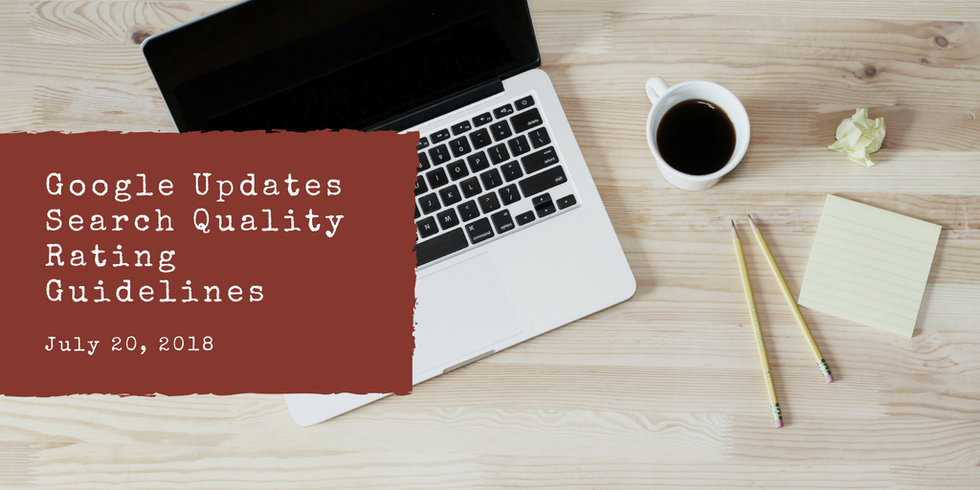
What Happened: Google first released its search quality rating guidelines in 2015, and has made several updates to them since. The search engine contracts with over 10,000 raters who evaluate the quality of Google's search results. In this latest update, the guidelines focus on the reputation of a site and its content creators. Jennifer Slegg, who has kept track of the guidelines over the years, told Search Engine Land that the focus on the quality of content creators may be what impacts sites the most. "They might have an 'About Us' page, but the bios of their authors are sorely lacking. It also means that those accepting contributions from those not working for the site in question need to keep an eye on the reputation of their contributors as well," she said.
In addition to tracking the quality and reputation of a site and its contributors, Google is also asking raters to rank sites low if the headline is either too sensational or doesn't adequately represent the content attached to it. It's an effort to combat spam and clickbait that's plagued the platform since 2016's fake news fallout.
Search Engine Land also reported that Google's quality guidelines will focus on the "beneficial purpose" of sites. The search engine will now evaluate how a piece of content delivers value to a reader. This means Google is actively straying away from articles that are clearly written for search optimization purposes.
What It Means: The rankings given by the quality raters will improve Google's algorithm, but they will not automatically deprioritize pages with a low rating. But over time, the data from raters may cause some pages who don't follow the latest guidelines to rank lower than before.
These changes present a good opportunity to make sure your site's "About Us" and contributor bio pages are well written and detailed. If you haven't already, begin to prioritize user experience and quality content overall, even in these lower priority sections of your site — and don't focus too much on keyword stuffing or traditional SEO writing methods when revamping.
July 9, 2018: Speed Update Debuts Worldwide

What Happened: Google is on time with the debut of its Speed Update, which was first announced in January 2018. The update solidifies page speed as a ranking factor on mobile pages. Fast mobile pages have always been preferred, but were never an official ranking factor in the eyes of Google. The search engine noted that this update will only impact the slowest of mobile sites, so shaving a few seconds off of your already fast mobile site won't impact your ranking too much. For publishers who use Google Accelerated Mobile Pages (AMP), Google will record the page performance of the AMP-specific URL.
What It Means: It should come as no surprise that having a fast mobile-loading experience isn't just a best practice anymore. It's become a mandatory strategy. If your site still feels too slow on mobile, take advantage of publishing to Google's AMP format to improve your SEO performance and deliver a better experience to your users.
May 13, 2018: Snippet Length Decreases

What Happened: Google's Danny Sullivan confirmed via Twitter to Search Engine Land that the character length of snippets — also known as meta descriptions — decreased in recent weeks. In December 2017, Google announced they had increased the length of snippets to 300+ characters. Data from RankRanger puts the average snippet length in recent weeks at 160. Sullivan said that while there is no set length, "length varies based on what our systems deem to be most useful."
What It Means: It does seem like a fickle move to decrease snippet length so quickly after increasing the character count just a handful of months earlier. Count this one as another move by Google to refine the algorithm for the most efficient and relevant results. It's possible that the longer length of snippets was causing too much noise in the rankings. The best way to adjust after this update is to keep meta descriptions concise, with as many contextually relevant keywords and phrases as possible.
April, 16, 2018: Another Core Search Ranking Algorithm Update
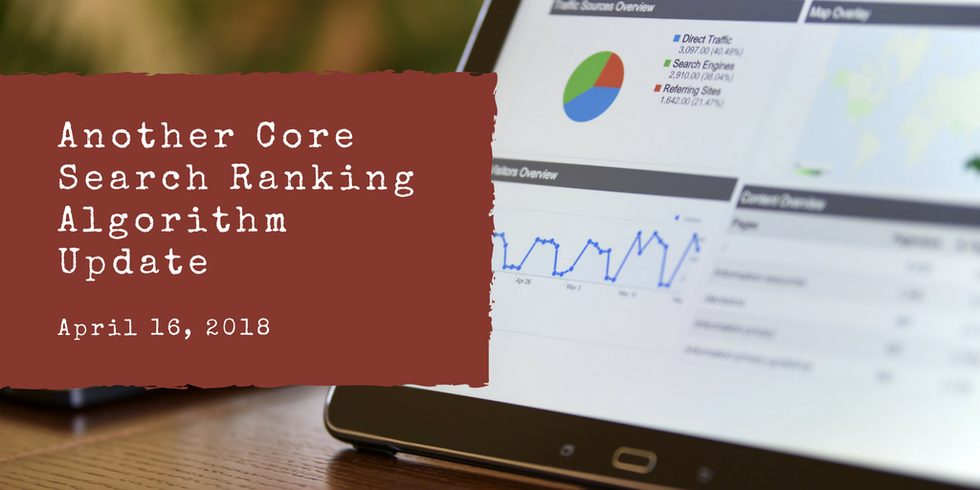
What Happened: On April 20, 2018, Google announced via their SearchLiaison Twitter account that they had rolled out another broad core algorithm update four days earlier. The algorithm update — which currently has no official name, and may never get one — is reportedly very similar to the one Google rolled out back on March 7, 2018. In essence, many pages are once again shifting in the rankings thanks to "routine updates." Google directed users to review their previous Twitter statement on the matter.
What It Means: The jury is still out on this update, as well as the "equivalent" one that took place in early March 2018. Some pages are claiming they've all but disappeared from the rankings for no discernible reason. But it's possible they were simply following bad practices that eventually caught up with them. Google claims that there's nothing you can do to offset these fluctuations outside of improving your site's quality for the next round of broad updates. And with that, we remain resolute on what you should do in the face of these recent upheavals — remain steadfast in continuing to create relevant, high-quality content that satisfies user intent and follows best practices.
April 7, 2018: Testing Quasi-Infinite Scroll on Mobile

What Happened: Google's Danny Sullivan confirmed via Twitter that the search giant is testing a form of infinite scroll in mobile search results. Unlike traditional infinite scrolling, once you reach the bottom of the mobile SERP, you need to click a "More results" button to load, well, more results. The button replaces the pagination that we've become accustomed to over the years. And while a number of people are picking up on this change in recent days — partially thanks to Danny's official comment on the matter — Google appears to have been testing this at least as far back as August 2017.
Why It Matters: Implications aren't clear since this is a test that may never fully materialize into something permanent. But it could mean that sites ranking on pages two and three of the SERP will see a marginal uptick in traffic depending on how overall user behavior takes to the change. A welcome result, no doubt, when traditionally 90–95% of searchers never make it past the first page of results. We'll be keeping a close eye on this one.
March 26, 2018: Rolling Out Mobile-First Indexing

What Happened: A long time coming, Google finally announced that they would roll out "mobile-first indexing" after over a year and a half of testing. Google has prioritized mobile sites in various ways prior to today, but this puts a big emphasis on mobile friendliness. Mobile-first indexing essentially means that Google will use the mobile version of a web page for indexing and ranking to better help users find what they're looking for.
What It Means: The majority of Google's users search on their phones, so this was an obvious next step for the algorithm. Now Google will look more to mobile rather than desktop, so it's more important than ever to make sure that your content is perfectly optimized on mobile to show up with any priority in Google's SERP.
March 19, 2018: Subscribe with Google
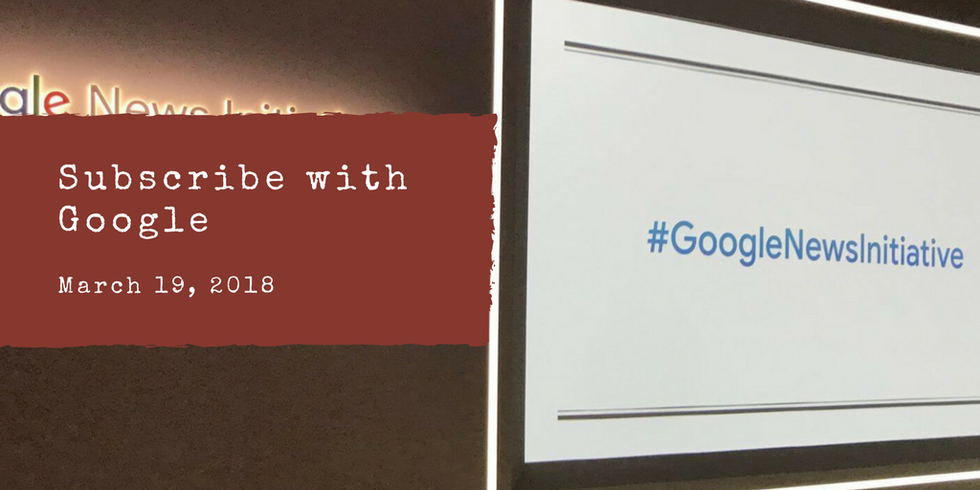
What Happened: Google introduced Subscribe with Google, a simple way to subscribe to your favorite news sources and access them anywhere, even within search results. Subscribe with Google is meant to cut out the lengthy ordeal of initiating the sign-up process, entering in all your payment information, and having to redo this over again every time you come across a new paywall. Instead, you can now simply buy a subscription to any participating news publisher using your Google account.
What It Means: As publishers shift to subscription-based models, Google is capitalizing on the movement by balancing out the needs of both publishers and consumers. Google is making the process of subscribing to premium content seamless, with literally the click of a button. Not only does it offer participating publishers a new revenue stream, it also gives preference to subscribed sites for search queries that target trending topics. According to Google, "paying for a subscription is a clear indication that you value and trust your subscribed publication as a source. So we'll also highlight those sources across Google surfaces, beginning with a dedicated module on Search."
March 13–20, 2018: Zero Search Results Experiment

What Happened: Google experimented with what turned out to be a week-long algorithm update — coined Zero Search Results — that eliminated all-but-one search result for queries that didn't necessarily need the others. This condensed view was intended to speed up load time and efficiency for users, particularly those on mobile in places where internet connections might not be as speedy. And for those who still wanted to view a full list of the search results, they could simply click a "Show all results" button to load what was hidden.
What It Means: This algorithm tweak was gone almost as soon as it came. Google didn't receive enough positive feedback, as users were confused and SEO experts were concerned about the implications of a truncated SERP down the line. Ultimately, the test couldn't survive the amount of user errors it generated, so Google nixed it entirely.
March 13, 2018: Update to Image Captions

What Happened: As changes to Google Image Search continue in 2018, Google will now display captions alongside images when searching on mobile. The new captions are pulled from the title tag of the page that hosts the image. Despite this change, there is reportedly no change to content rankings. Google continues to use a variety of signals from landing pages to deliver the most relevant results to users.
What It Means: This adds even more context to images, so users can easily understand what images are about and whether the site they're on is pertinent to what they're looking for.
March 9, 2018: Google Further Clarifies Their October 27, 2017 Update to Country Services
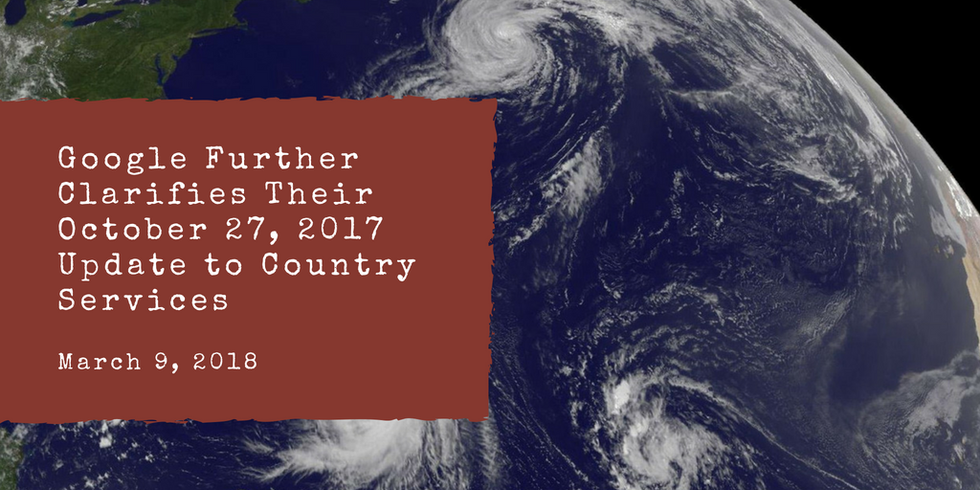
What Happened: On October 27, 2017, Google announced an update concerning the way it handled country services, changing results that populated via Search to be based on a user's location settings versus a site's domain. For example, if you were in the United States and pulled up Google — either via your iOS app, desktop, mobile browser, or Maps — you would've been given the U.S.-specific version of any sites returned. If you later traveled to Italy, your country-based location would automatically update and Google's results would follow suit. So far so good, unless you were interested in search results outside of your current location. Then it was a tad annoying.
The reason this update was noteworthy is because prior to October, Google's algorithm was indexing country pages together on many sites thinking they were duplicate pages. Why was it doing this? Well, when it comes to English-based web pages — for instance — a lot of content tends to be the same. You may have Australian and Canadian versions of your website, but chances are the content between the two is similar, if not identical in most aspects. So Google was consolidating these similar pages in order to only deliver the best version of a result to users. All in the name of user experience, of course. The reason this became an issue in conjunction with the October 27, 2017 update is because the consolidation process often disregarded important pieces of contextual information, such as hreflang attributes — which is a piece of code added to your pages to let Google know what language the content is written in. The outcome? Google Search users were now getting results in the wrong language and/or seeing the wrong country version of a page.
Google recognized this issue rather quickly, and released an update to address it, citing that the search engine now respects hreflang tags. According to Search Engine Land, Google's Senior Webmaster Trends Analyst, John Mueller, said the following during a March 9, 2018 web conference:
"We can follow the hreflang links as well, even in cases where we pick one version as a canonical. This is really common in cases where the same language content is used across multiple countries, then what we might say is we understand the hreflang links between these different versions and we understand that the content is actually the same so we pick one version of the content to index but we swap out the URLs anyway because of the hreflang connection that we have … What also sometimes happens is that we understand the language or country based on other factors like URL, internal linking, different language or country links, then sometimes we can pick up those connections even without clear hreflang guidance."
Since then, the changes have largely resolved the location issues caused by the orginal update. But it's not faultless, yet.
What It Means: While it's good news that Google has mostly resolved this somewhat complicated update, it reinforces the need to diversify your content as much as possible. If you're producing multiple pages of new content on a regular basis, be sure to keep the content original when you're writing for different locales. This will not only provide a better, more relevant experience for your users, but it'll also diminish the chances of your pages getting labeled as duplicate content by Google — which is never a good thing.
March 7, 2018: Core Search Ranking Algorithm Update

What Happened: Google confirmed that they pushed out a nameless "broad core algorithm update," which they say happens a couple times a year. This core update had an effect on the appearance and rankings of various sites in the SERP, though the platform insists there's nothing specifically you can do to fix any drop as a result. If a page drops in the SERP, it doesn't necessarily mean that there's something wrong with it. Google says that the "under-rewarded pages" just happened to benefit more from the update.
What It Means: In a series of tweets announcing the update, Google insisted that there is no immediate fix for any changes in ranking, and instead urged businesses to keep doing what they've been doing all along: Focus on publishing good, quality content that will lead you to outrank competitors in the SERP over time.
March 5, 2018: New Ways to Search on iOS
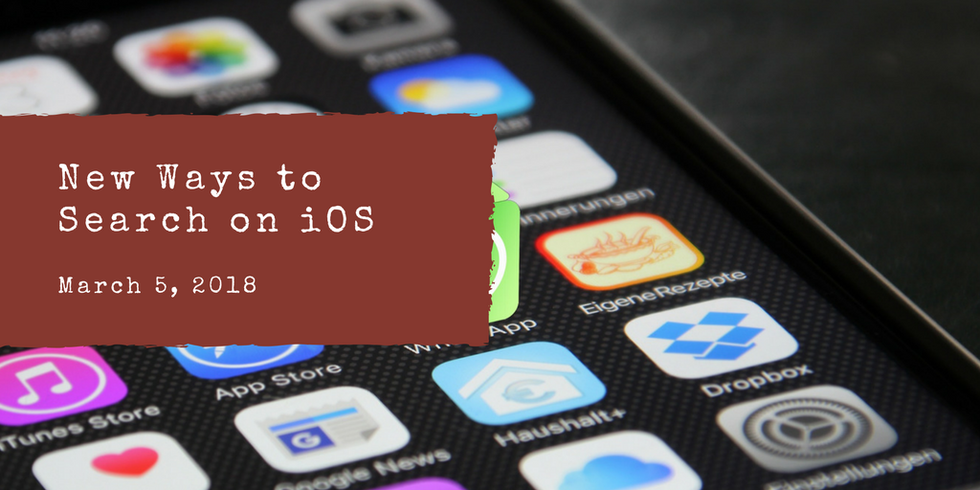
What Happened: Ever wanted to search for a place to go out to dinner at from right within a conversation? Well, now you can. Google introduced a new addition to the Search app for iOS that allows you to quickly search the web and add results to your iMessage conversations. Each result includes a "Share" button to do this easily.
What It Means: This is a new way for users to discover relevant content, and then turn around and use it in places they like to live, such as iMessage. You can easily search for information without leaving the app. It's only available in the United States as of now, but the new capabilities will soon roll out to iOS users globally.
February 28, 2018: Multifaceted Featured Snippets
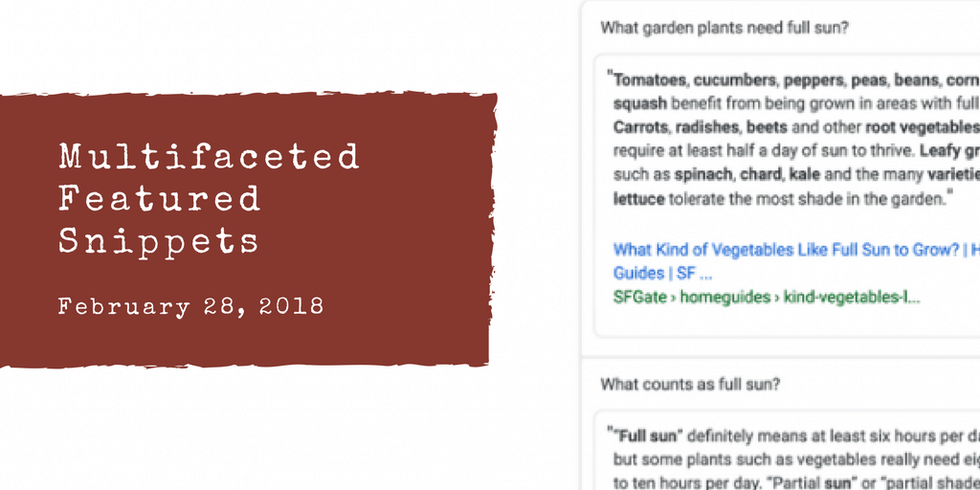
What Happened: Google updated its search results features to now include multifaceted featured snippets. These snippets will appear for nuanced queries that are broad enough to have more than one interpretation. The aim is to provide more comprehensive results for questions that don't have one specific answer, which means the SERP returned might feature multiple snippets instead of just one. Each snippet will display the original query rewritten as questions the algorithm assumes was intended. Multifaceted featured snippets will roll out for mobile first, and then desktop later on down the road in 2018.
What It Means: This update will most certainly provide anyone performing a search with a more comprehensive set of results for multi-intent query scenarios.
February 20, 2018: Support Dropped for News Meta Keywords Tag
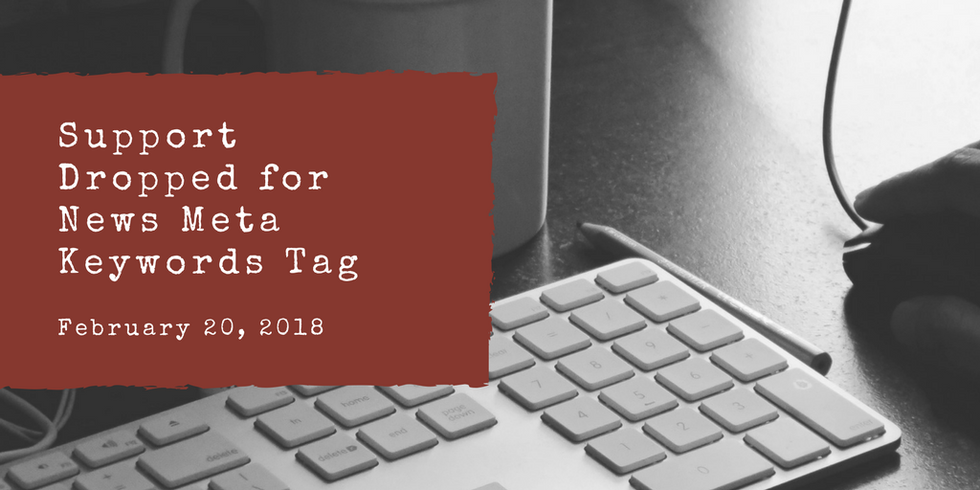
What Happened: News publishers who use the news meta keywords tag can officially stop using the feature. It was introduced back in 2012 as a way for news publishers to have a better chance at ranking for words that weren't necessarily included in their articles' headlines. But Google realized that only 5% of publishers actually used it, so they quietly starting ignoring the feature until it became completely obsolete in functionality.
What It Means: Since the news meta keywords tag will no longer have any effect on your SERP rankings, you can stop using them as well. It's okay to keep them in your previously published content, but they will not be used for Google News anymore. News publishers should stick to other valuable SEO practices instead, and continue creating content that is engaging and shareable to stand out in the rankings.
February 13, 2018: Introducing Google AMP Stories
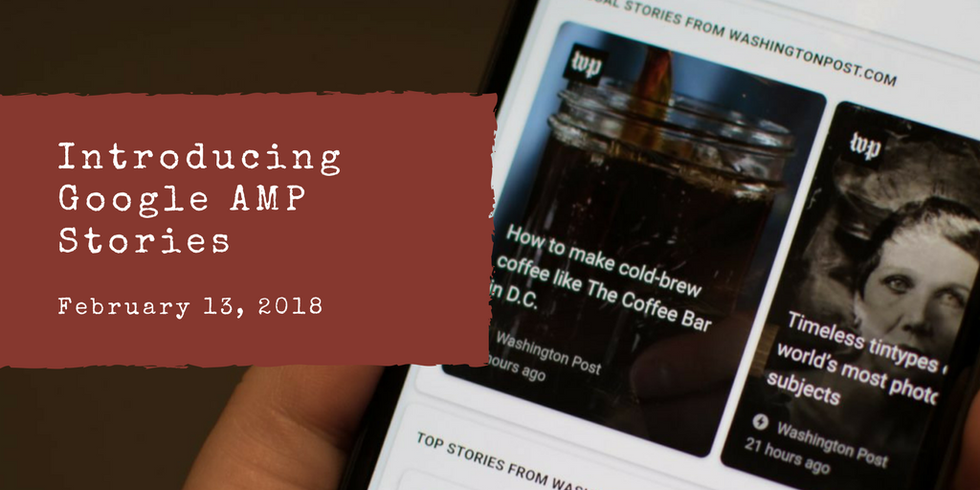
What Happened: Move over Facebook and Snapchat, Google officially rolled out AMP stories as another way to create visual storytelling on the mobile web. It allows publishers to "deliver news and information as visually rich, tap-through stories." To avoid canonical and content consistency issues, Google encourages publishers to create content specifically for stories rather than repurposing existing content.
What It Means: This is yet another familiar outlet for publishers to create compelling content that captivates their readers, and it's designed to generate more engagement from users. Publishers can utilize AMP stories to create a highly compelling and visual story over the course of a couple slides. Google has designed AMP stories to include built-in monetization capabilities, so it's a valuable way for publishers to capitalize on another revenue stream.
February 13, 2018: New and Improved “People Also Search For” Suggestions

What Happened: Notice anything different about the way search results appear on desktop? That's because Google officially rolled out a new look and design for the "People also search for" suggestions box. If you search for something on Google, click the result and let it load, then click back to your search results. What you'll notice now is that a suggestions box appears under the result you originally clicked with related search queries. Google had been testing various designs of this feature back in November 2017, and finally gave this current version the green light in mid February.
What It Means: This is a small, but significant tweak in terms of what information Google provides to its users. Previously, the "People also search for" suggestions box appeared at the bottom of the SERP. Now it's dynamic and moves around with the user. We already know that Google measures click-through rate and viewport time to gauge user satisfaction. This update should continue to help them predict what search results satisfy users, which could ultimately have an impact on your pages' positioning in Google's SERP. Again, publishing quality, relevant content and choosing the right keywords to target should always be your core focus when trying to grow an audience.
February 6, 2018: A New Search Console for Everyone

What Happened: Google's new and improved beta version of its Search Console is officially available to everyone. Since it's a beta, the old interface remains up and running, and you can use either at your convenience. Through user feedback, the Google team was able to tweak features across the user interface and backend architecture. You'll notice a new design for the Performance report, as well as many other updated features.
What It Means: If you're not already taking advantage of Google Search Console, now is a great time to start. It's a valuable tool for marketers and developers that lets you monitor information about your site's visitors. Start diving into Search Console's features to better tailor content for your users, and make sure to keep up with all of the updates that Google rolls out.
January 17, 2018: Page Speed Becomes a Mobile Ranking Factor

What Happened: Google announced that their latest algorithm update, dubbed the Speed Update, will officially come into effect in July 2018. Though page speed has been a ranking factor on desktop since 2010, Google has yet to apply it to mobile pages. As of July, page speed will officially become a part of mobile's page placement in Google's SERP. For pages that utilize Google AMP, Google will record the page speed according to the performance of the AMP URL.
What It Means: This is another reminder and push to make sure that all of your site's pages are perfectly optimized for the best user experience you can offer. If you're not already taking advantage of Google AMP, it's time to utilize the format to maximize your SEO on mobile. Before this update rolls out, be sure to measure your page speed and make improvements where necessary.
January 10, 2018: Revamped PageSpeed Insights Tool

What Happened: Google updated its PageSpeed Insights tool to include data from Google Chrome users, specifically from "real-world Chrome users who experience popular destinations on the web." Now the tool will show how fast your pages load compared to the data they've been collecting, and you'll be rated as fast, slow, or average in comparison. It's important to note that not all sites will be rated, but rather only those that Google has gathered enough data from via the Chrome user experience report.
What It Means: Page speed is an important factor in user satisfaction. Page speed affects user experience from the start, so it's no surprise that it's a critical SEO factor that impacts your search rankings. Pages with longer load times tend to have higher bounce rates, which is a red flag to Google. You need to make sure your pages load as quickly as possible, which in turn will help your organic growth and social ROI.
December 2017: The Maccabees Update
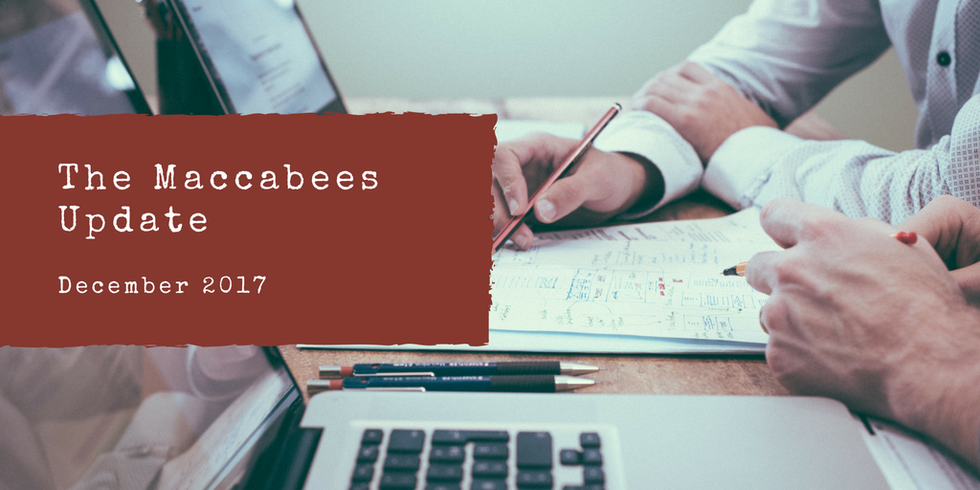
What Happened: At the end of 2017, rumors suggested that another Google algorithm update was in the works. When Google finally confirmed that several minor changes were made to its core algorithm in mid December, the Maccabees update was born. Maccabees — named by Search Engine Roundtable's Barry Schwartz in recognition of Hanukkah — was an extension of the Google Fred algorithm update that dropped in March 2017. In short, the update was meant to improve search relevance and create a better user experience. Affiliate and low-quality sites saw the biggest drop in traffic as a result of this update.
What It Means: This update was another reminder that using black hat SEO tactics and publishing poor-quality content will result in punishment from Google. It emphasizes the importance of creating reputable content to generate high-quality backlinks — the main driver of organic traffic. Similarly, website owners and webmasters should always strive to improve on-page and off-page relevance signals. If you didn't notice a drop in traffic back in December, congrats! That means you're creating great content using best practices.







































































